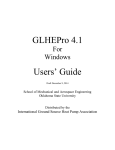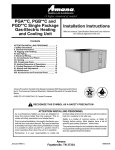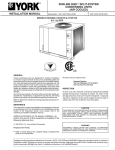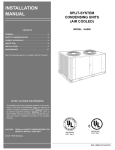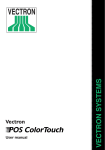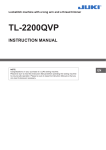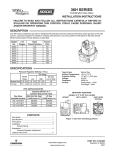Download RPGE/RGE Series
Transcript
INSTALLATION INSTRUCTIONS RPGE/RGE Series Gas Heating/Electric Cooling Package Unit Save these instructions for future reference WARNING Improper installation, adjustment, alteration, service, or maintenance can cause injury or property damage. Refer to this manual. For assistance or additional information, consult a qualified installer, service agency, or the gas supplier. TABLE OF CONTENTS WARNING Do not store combustible materials, including gasoline and other flammable vapors and liquids, near the furnace, vent pipe, or warm air ducts. Such actions could cause property damage, personal injury, or death. INSTALLATION ...................................... 2 START-UP .............................................. 8 OPERATION ........................................ 10 Cooling System ............................... 10 Heating System............................... 10 WARNING Never use a flame to check for gas leaks. Explosion causing injury or death may occur. MAINTENANCE .................................... 11 CONTROL SYSTEM DIAGNOSTICS .. 12 WIRING DIAGRAM .............................. 13 WARNING If this unit is to be installed in a mobile or manufactured home application, the ductwork must be sized to achieve static pressures within the manufacturer’s guidelines. All other installation guidelines must also be followed. Failure to do so may result in equipment damage, personal injury, and improper performance of the unit. Manufactured By Allied Air Enterprises, Inc. A Lennox International Company 215 Metropolitan Drive West Columbia, SC 29170 *506271-01* CAUTION The installation of the furnace, wiring, warm air ducts, venting, etc. must conform to the requirements of the National Fire Protection Association; the National Fuel Gas Code, ANSI Z223.1 (latest edition) and the National Electrical Code, ANSI/ NFPA No. 70 (latest edition) in the United States; the Canadian Installation Codes CAN/CGA-B149.1 & .2 (latest edition) and the Canadian Electrical Code Part 1, CSA 22.1 (latest edition) in Canada; and any state or provincial laws, local ordinances, or local gas utility requirements. Local authorities having jurisdiction should be consulted before installation is made. Such applicable regulations or requirements take precedence over the general instructions in this manual. 506271-01 Issue 0921 Page 1 of 14 INSTALLATION These instructions must be hung on or near the furnace in a conspicuous place. These furnace units are single package air conditioners with gas heat designed for outdoor installation on a rooftop or a slab. The units are completely assembled. All piping, refrigerant charge, and electrical wiring are factory installed and tested. The units require only electric power, gas piping, condensate drain, and duct connections, plus instruction of the vent cover at the point of installation. If components are to be added to a unit to meet local codes, they are to be installed at the dealer’s and/or customer’s expense. The size of unit for the proposed installation should be based on heat loss/heat gain calculation made according to the methods of Air Conditioning Contractors of America (ACCA). See Table 1 for application limitations. Inspection As soon as the unit is received, it should be inspected for possible damage during transit. If damage is evident, the extent of the damage should be noted on the carrier’s freight bill. A separate request for inspection by the carrier’s agent should be made in writing. Location Use the following guidelines to select a suitable location for these units. 1. Unit is designed for outdoor installation only. Unit must be installed so all electrical components are protected from water. 2. Condenser coils must have an unlimited supply of air. 3. For ground level installation, use a level prefabricated pad or use a level concrete slab. Do not tie the slab to the building foundation. 4. Maintain level within a tolerance of 1/4" maximum across the entire length or width of the unit. 5. Do not locate the unit where the combustion air supply will be exposed to any of the following substances: WARNING In the State of Massachusetts: This product must be installed by a licensed Plumber or Gas Fitter. When flexible connectors are used, the maximum length shall not exceed 36". When lever-type gas shutoffs are used, they shall be T-handle type. These installation instructions are intended as a general guide only, for use by an experienced, qualified contractor. These units are certified by E.T.L. Testing Laboratories, Inc.: • For use as a forced air furnace with cooling unit. • For outdoor installation only. • For installation on combustible material. • For use with natural gas or propane gas. (Conversion kit required for propane gas application.) These units are not suitable for use with conventional venting systems. Page 2 of 14 Issue 0921 • Permanent wave solutions • Chlorinated waxes and cleaners • Chlorine-based swimming pool chemicals • Water softening chemicals • Deicing salts or chemicals • Carbon tetrachloride • Halogen-type refrigerants • Cleaning solvents (such as perchloroethylene) • Printing inks, paint removers, varnishes, etc. • Cements and glues • Antistatic fabric softeners for clothes dryers • Masonry acid washing materials • Chlorinated laundry products • Hydrochloric acid 506271-01 Clearances All units require certain clearances for proper operation and service. Refer to Table 2 for the minimum clearances to combustibles required for construction, servicing, and proper unit operation. CAUTION Before lifting a unit, make sure that the weight is distributed equally on the cables so that it will lift evenly. Exercise care when moving the unit. Do not remove any packaging until the unit is near the place of installation. An accessory lift kit can be purchased to aid in rigging. Spreaders whose length exceed the largest dimension across the unit must be used across the top of the unit. Clearance to combustibles below the unit flue is 10" since the flue points down. Do not permit overhanging structures or shrubs to obstruct condenser air discharge outlet, combustion air inlet, or vent outlet. Units may also be moved or lifted with a forklift while still in the factory supplied packaging. The lengths of the forks of the forklift must be a minimum of 42". Minimum Clearances to Combustibles Roof Curb Installation If a roof curb is used, follow the manufacturer’s Installation Instructions and be sure that all required clearances are observed (see Clearances section on this page). This unit is shipped with four corner brackets in place on the underside of the unit (see Figure 1). All four brackets must be removed before unit is installed onto roof curb assembly. Front of Unit 24” Back of Unit 2” Left Side 12” Right Side (from Vent Cover) 15” Below Unit * 0” * Minimum clearance to combustible material below the flue is 10" to allow proper dissipation of flue gasses and temperatures. To avoid interference with roof curb remove the outer most screw attaching the outdoor coil filler panel to the unit base, and calk the open hole. Table 1 In the U.S., units may be installed on combustible floors made from wood or class A, B, or C roof covering material. In Canada, units may be installed on combustible floors. Units must be installed outdoors. Corner Brackets Bracket Bracket Return Supply Coil Close Off Service Access Access to all serviceable components is provided by four removable panels: blower compartment, evoporator coil/filter compartment, burner compartment, and main control box. Combustion Discharge The vent outlet must be installed in a location as to prevent building degradation and must be consistent with the National Fuel Gas Code, Z223.1 or CAN/CGA-B149.1 & .2. Bracket Bracket Remove all four (4) corner brackets before installing on roof curb. Figure 1 The products of combustion are discharged through a screened opening on the gas heat side panel. The horizontal vent system shall terminate at least 4' below, 4' horizontally from, or 1' above any door, window, or gravity air inlet into the building. The vent system shall terminate at least 3' above any forced air inlet located within 10'. The unit shall be installed in a manner such that snow accumulation will not restrict the flow of flue products. 506271-01 Issue 0921 Page 3 of 14 Minimum horizontal clearance of 4' from electric meters, gas meters, regulator, and relief equipment is required. In addition to the above requirements, consideration must be given to prevent unwanted ice buildup from the vent condensate. The vent should not be located on the side of a building where the prevailing winter winds could trap the moisture, causing it to freeze on the walls or on overhangs (under eaves). The vent location should not discharge over a sidewalk, patio, or other walkway where the condensate could cause the surface to become slippery. The products of combustion must not be allowed to accumulate within a confined space and recirculate. Vent Cover For shipping purposes, the unit is shipped with the vent cover packaged in the unit supply air compartment. Retrieve the vent cover from the supply air compartment. To attach the vent cover to the unit: 1. Locate the vent screen. It is packed in the plastic bag that contains these Installation Instructions. 2. Remove the two screws that will be used to attach the screen to the unit (see Figure 2). 3. Center the screen over the hole and re-insert the screws removed in Step 2. 4. Remove the 4 screws that will be used to attach the vent cover (see Fig. 3). Install the vent cover using these screws. A properly installed vent cover will not extend above the top of the unit. Installing the Vent Cover Screen Screen attachment screws Removal of Unit from Common Venting System When an existing furnace is removed from a common venting system serving other appliances, the venting system is likely to be too large to properly vent the remaining attached appliances. The following test should be conducted with each appliance while the other appliances connected to the common venting system are not in operation. 1. Seal any unused openings in the common venting system. 2. Visually inspect the venting system for proper size and horizontal pitch and determine there is no blockage or restriction, leakage, corrosion, or other deficiencies which could cause an unsafe condition. 3. Insofar as is practical, close all building doors and windows between the space in which the appliances remaining connected to the common venting system are located and other spaces in the building. Turn on clothes dryers and any appliance not connected to the common venting system. Turn on exhaust fans, such as range hoods and bathroom exhausts, so they will operate at maximum speed. Do not operate a summer exhaust fan. Close fireplace dampers. 4. Following the lighting instructions, place the unit being inspected in operation. Adjust the thermostat so the appliance will operate continuously. 5. Test for spillage at the draft control relief opening after 5 minutes of main burner operation. Use the flame of a match or candle. 6. Follow the preceding steps for each appliance connected to the common venting system. 7. After it has been determined that each appliance remaining connected to the common venting system properly vents when tested as outlined above, return doors, windows, exhaust fans, fireplace dampers, and any other fuel burning appliance to their previous condition of use. Vent Cover Attachment Screws (Plus 2 on other side) Vent Cover Figure 2 Page 4 of 14 NOTE: If a gas furnace that’s connected to a common venting system is being removed when this package unit is installed, then read and follow the instructions in the “Removal of Unit from Common Venting System” section that follows. Otherwise, you may skip this section. 8. If improper venting is observed during any of the above tests, the common venting system must be corrected. See National Fuel Gas Code, ANSI Z223.1 (latest edition) or CAN/CGA B149.1 & .2 Canadian Installation Codes to correct improper operation of common venting system. Issue 0921 506271-01 Ductwork Ductwork should be designed and sized according to the methods in Manual Q of the Air Conditioning Contractors of America (ACCA). Minimum Required Surface Area for Disposable Filters A closed return duct system shall be used. This shall not preclude use of economizers or outdoor fresh air intake. It is recommended that supply and return duct connections at the unit be made with flexible joints. The supply and return air duct systems should be designed for the CFM and static requirements of the job. They should not be sized by matching the dimensions of the duct connections on the unit. Filters Filters are not supplied with the unit. Filters must always be installed ahead of the evaporator coil and must be kept clean or replaced. Dirty filters will reduce the airflow of the unit. Filters should be sized in accordance with Table 3. This unit is equipped with an internal filter clip which is located in the indoor coil compartment attached to the side of the unit drain pan. Table 2 Gas Piping Proper sizing of a gas piping depends on the cubic feet per hour of gas flow required, specific gravity of the gas, and length of run. National Fuel Gas Code Z223.1 latest edition should be followed in all cases unless superseded by local codes or gas company requirements. In Canada, refer to CAN/CGA B.149.1 & .2 (latest edition). CAUTION When fastening ductwork to the side duct flanges on unit, insert screws through duct flanges only. Do not insert screws through the casing. Outdoor ductwork must be insulated and waterproofed. The heating value of the gas may differ with locality. The value should be checked with the local gas utility. For temperature rise of unit, see unit rating plate. Condensate Drain This package unit is equipped with a 3/4" FPT coupling for condensate line connection. Plumbing must conform to local codes. Use a sealing compound on male pipe threads. Typical Condensate Drain Connection The condensate drain line must be properly trapped and routed to a suitable drain. See Figure 3 for proper drain arrangement. The drain line must pitch to an open drain or pump to prevent clogging of the line. Seal around the drain connection with suitable material to prevent air leakage into the return air system. Figure 3 506271-01 Issue 0921 Page 5 of 14 Gas piping recommendations: WARNING • A drip leg and a ground joint union must be installed in the gas piping. A ground joint union is recommended by the manifold/valve. • When required by local codes, a manual shutoff valve may have to be installed outside of the unit. • Use pipe thread sealing compound resistant to propane gas sparingly on male threads. • Never use a flame to check for gas leaks. Explosion causing injury or death may occur. The gas supply should be a separate line and installed in accordance with all safety codes listed on page 1. After the gas connections have been completed, open the main shutoff valve admitting normal gas pressure to the mains. Check all joints for leaks with soapy solution or other material suitable for the purpose. • The furnace and its individual manual shutoff valve must be disconnected from the gas supply piping system during any pressure testing of that system at test pressures in excess of 1/2 PSIG (3.48kPa). • A 1/8" N.P.T. plugged tapping, accessible for test gauge connections, must be installed immediately upstream of the gas supply connection to the furnace. Gas Connection The gas supply line should be routed through the grommet on the side of the unit. WARNING The furnace must be isolated from the gas supply piping system by closing the individual manual shutoff valve during any pressure testing of gas supply piping system at test pressures equal to or less than 1/2 psig or 14" w.c. If the piping system is to be tested at pressures in excess of 1/2 psig, the furnace and its individual shutoff valve must be disconnected from the gas supply piping system. Typical Field Wiring Thermostat Weatherproof Disconnect Switch 48" Overhead Clearance To Power Supply NEC Class 1 Wiring NEC Class 2 Wiring To Unit Power Entry To Low Voltage Entry Vent Cover 12" Clearance (Both Sides) 2" Clearance Rear 15" Clearance To Vent Cover 24" Clearance From Front Gas Entry Power Entry NOTE: All outdoor wiring must be weatherproof. Low Voltage Entry Figure 4 Page 6 of 14 Issue 0921 506271-01 LPG/Propane Units, Tanks, and Piping Units are shipped equipped for natural gas, but can be converted to LPG/propane in the field by an approved licensed technician. If conversion is required, use the approved conversion kit. When converting a low NOx unit (designated by an L in the model number) to propane, the NOx inserts must be removed. After removing the burners, remove the screw holding each insert and pull the insert from the combustion chamber. The screws must be reinstalled in the vest panel after the inserts are removed. comply with all applicable codes. A fused disconnect switch should be field provided for the unit. The switch must be separate from all other circuits. If any of the wire supplied with the unit must be replaced, replacement wire must be of the type shown on the wiring diagram. Electrical wiring must be sized to carry minimum circuit ampacity marked on the unit. Use copper conductors only. Each unit must be wired with a separate branch circuit and be properly fused. CAUTION All LPG/propane gas equipment must conform to the safety standards of the National Fire Protection Association. When connecting electrical power and control wiring to the unit, waterproof type connectors must be used so that water or moisture cannot be drawn into the unit during normal operation. For satisfactory operation, LPG/propane gas pressure must be a minimum of 11" w.c. at the unit under full load. Complete information regarding tank sizing for vaporization, recommended regulator settings, and pipe sizing is available from most regulator manufacturers and LPG/propane gas suppliers. Check all connections for leaks when piping is completed, using a soapy solution. Some soaps used for leak detection are corrosive to certain metals. Carefully rinse piping thoroughly after completing leak detection. Electrical Wiring (See Figures 4 & 5) Thermostat The room thermostat should be located on an inside wall where it will not be subject to drafts, sun exposure, or heat from electrical fixtures or appliances. Follow the manufacturer’s instructions enclosed with thermostat for general installation procedure. Color-coded insulated wires (#18 AWG) should be used to connect the thermostat to the unit. Four wires are required for cooling. The heat anticipator setting is 0.75 amp. All wiring should be done in accordance with the National Electrical Code, ANSI/NFPA No. 70 (latest edition); Canadian Electrical Code Part 1, CSA C22.1 (latest edition); or local codes where they prevail. Use wiring with a temperature limitation of 75°C minimum. Run the 208 or 230 volt, 60 hertz electric power supply through a fused disconnect switch to the control box of the unit and connect as shown in the wiring diagram located on the inside of the control access panel. Power supply to the unit must be N.E.C. Class 1, and must Compressor Units are shipped with compressor mountings factoryadjusted and ready for operation. Caution: Do not loosen compressor mounting bolts. Power Wiring Line Voltage 208/230 Volts CONTACTOR FIELD-SUPPLIED FUSED DISCONNECT GROUND LUG SINGLE PHASE POWER SUPPLY If 208 volt is supplied, transformer connections must be made. Figure 5 506271-01 Issue 0921 Page 7 of 14 To Light Main Burners: 1. Turn off electrical power to unit. START-UP For Your Safety Read Before Lighting 2. Turn the thermostat to lowest setting. CAUTION 3. Turn the gas valve knob to the “ON” position (see Figure 7). Furnace is equipped with a direct ignition control. Do not attempt to manually light the burners. 4. Turn on electrical power to the unit. 5. Set the room thermostat to the desired temperature. (If the thermostat “set” temperature is above room temperature after the pre-purge time expires, main burners will light.) Pre-Start Check List Complete the following checks before starting the unit: 1. Check the type of gas being supplied. Be sure it is the same as listed on the unit nameplate. 2. Make sure that the vent cover has been properly installed. To Shut Down Main Burners: 1. Turn off electrical power to unit. 2. Turn the gas valve switch to the “OFF” position (see Figure 7). Typical Wiring Connections Regulator Adjustment (Under Cap) Gas Valve Gas Control Switch Figure 7 Post-Start Check List After the entire control circuit has been energized and the heating section is operating, make the following checks: 1. Check for gas leaks, using soapy solution, in the unit piping as well as the supply piping. 2. Check for correct manifold gas pressures (see Manifold Gas Pressure Adjustment Regulator sections). 3. Check the supply gas pressure. It must be within the limits shown on the rating plate. Supply pressure should be checked with all gas appliances in the building at full fire. At no time should the standby gas pressure exceed 13" w.c., nor the operation pressure drop below 5" w.c. for natural gas units or 11" w.c. for propane gas. If gas pressure is outside these limits, contact the gas supplier for corrective action. Figure 7 Page 8 of 14 4. Adjust temperature rise to the range specified on the rating plate. Issue 0921 506271-01 Manifold Gas Pressure Adjustment Regulator – Natural Gas To check this pressure: 1. Turn off gas valve. For purpose of input adjustment, the minimum permissible gas supply pressure is 5" w.c. for natural gas. Gas input must never exceed the input capacity shown on the rating plate. The furnace is equipped for natural gas rated inputs with manifold pressure of 3.5" w.c. The manifold pressure can be measured by shutting off the gas, removing the pipe plug in the downstream side of the gas valve, and connecting a water manometer or gauge. Under no circumstances should the final manifold pressure vary more than 0.3" w.c. from the above specified pressures. To adjust the regulator, turn the adjusting screw on the regulator clockwise to increase pressure and input or counterclockwise to decrease pressure and input. See Figure 8 to assist in locating the regulator on the gas valve. Check the furnace rate by observing the gas meter, making sure all other gas appliances are turned off. The test hand on the meter should be timed for at least one revolution, noting the number of seconds per revolution. The heating value of the gas can be obtained from the local utility. Example: By actual measurement, it takes 38 seconds for 2. Remove plug on valve marked “OUTLET PRESSURE.” 3. Install a water manometer. 4. Turn on gas valve and initiate a call for heat. If manifold pressure must be adjusted, remove cap from pressure regulator and turn adjustment screw clockwise to increase pressure or counterclockwise to reduce pressure. 5. After checking pressure, turn gas off, remove manometer fitting, and replace pipe plug and regulator cap. 6. Put furnace in operation and check plug for leaks using soapy solution. Burner and Burner Orifice Instructions To check or change burners or burner orifices: 1. Close the main manual gas shutoff valve and turn off all power to unit. 2. Remove the burner access panel. BTU/HR Cubic Feet Per Revolution x 3600 x Heating = INPUT # Seconds Per Revolution Value the hand on the 1-cubic foot dial to make a revolution with a 100,000 BTU/HR furnace running. The result is 99,750 BTU/ HR, which is close to the 100,000 BTU/HR rating of the furnace. Manifold Gas Pressure Adjustment Regulator – LPG/Propane Gas LPG/propane units require a regulator, and a regulator on the LPG/propane tank is also required. For purpose of input adjustment, the minimum permissible gas supply pressure (inlet side of gas valve) is 11" w.c. for LPG/propane. If at any time ignition is slow and burner does not seem to be operating correctly, check manifold pressure (outlet side of the gas valve). It should be 10" to 10.5" w.c. pressure for LPG/propane. The furnace is designed to obtain rated input at 10" w.c. manifold pressure for propane. 506271-01 3. Disconnect the union in the gas supply line upstream of the gas valve and downstream of the manual shutoff valve. 4. Label wires going to the gas valve, then disconnect the wires. 5. To change orifice: a. Remove 4 screws that fasten the manifold to the burner box assembly and remove the manifold. b. Remove the orifices, then install replacement orifices. c. To reassemble: Reverse above steps, making sure orifices are inserted into the orifice holders on the back end of the burners, and that burners are level and centered on each burner opening in the vest panel. 6. To remove or service burners: a. Label and disconnect the wires to the rollout switch and disconnect the igniter and flame sensor leads at the ignition control. b. Remove the 4 screws that secure the burner box assembly to the vest panel and remove the assembly from the unit. c. Remove the 6 screws that fasten the burner rack and bottom shield assembly to the burner box. Burners are now accessible for removal. d. To Reassemble: Reverse above steps. Issue 0921 Page 9 of 14 7. After reassembly of all parts is complete and all wires are reconnected, open the main manual gas shutoff valve; check for and correct any gas leaks. Turn electrical power on, initiate a call for heat, and check for proper burner operation. 8. Install burner access panel. For maximum performance of the cooling system, operating temperatures and pressure should be checked. Superheat should be determined at Standard ARI test conditions of 82°F outdoor and 80°F indoor dry bulb/67°F wet bulb. If superheat measured deviates from values found in Table 3, refrigerant charge should be adjusted accordingly for maximum performance. does not sense that a flame has been established in the Heat Anticipator The heat anticipator setting is 0.75 amp. It is important that the anticipator setpoint be correct. Too high of a setting will result in longer heat cycles and a greater temperature swing in the conditioned space. Reducing the value below the correct setpoint will give shorter “ON” cycles and may result in the lowering of the temperature within the conditioned space. Suction Superheat OPERATION * This letter will vary according to furnace series. Cooling System The cooling system is a complete factory package utilizing an air-cooled condenser and is factory-charged with HFC-R-410A. The compressor is hermetically sealed and base mounted with rubber-insulated hold-down bolts. Unit compressors have internal protection. In the event there is an abnormal rise in the temperature of the compressor, the protector will open and cause the compressor to stop. Preliminary Operation Cooling After the initial installation, the compressor should be given three false starts (energized just long enough to make a few revolutions), with 5 – 7 minutes between each start, before being put into full-time service. Cooling Sequence of Operation When the thermostat calls for cooling, R is closed to G and Y (see the wiring diagram found on page 13). This action completes the low voltage control circuit, energizing the compressor, condenser fan motor, and blower motor. Blower Delay – Cooling The circulating air blower is controlled by a timing circuit in the integrated blower/ignition control. Timings are not adjustable. Blower “ON” delay is 5 seconds after the compressor starts and blower “OFF” timing is 90 seconds after the cooling system shuts down. Table 3 Heating System With the proper thermostat and sub-base, continuous blower operation is possible by closing the R to G circuit. Cooling blower delay is also functional in this mode. Heating Sequence of Operation The following sequence describes the operation of the gas heat section. 1. When the thermostat calls for heat, the draft motor is energized by the 24-volt relay in the blower ignition control which closes the 240V contact to the draft motor. 2. When the speed of the draft motor reaches proper RPM, the pressure switch closes to power the ignition control. 3. When PSW on ignition control is energized, a pre-purge time is initiated (30 seconds nominal). 4. When pre-purge has expired, the gas valve is energized for direct ignition. The ignition control energizes the main gas valve and spark electrode for a period of 10 seconds. 5. Thirty seconds nominal after the initial trial for ignition, the circulation air blower will start. If the flame sensor System Performance Page 10 of 14 Issue 0921 506271-01 10-second interval, then the ignition control will deenergize the gas valve. 6. The ignition control is designed to repeat this “trial for ignition” a total of three times. If, at the end of the third trial, flame still has not been established, then the ignition control will try to light again 1 hour later. The 1-hour retry is indefinite. The ignition control can be reset by interrupting the unit power or the thermostat circuit. 7. When the thermostat is satisfied, the draft motor and gas valve are de-energized. The blower motor will continue to run for a short period after the furnace is shut down. High Altitude The input rate shown on the rating plate is for elevations up to 2000 feet. For elevations from 2001 to 4500 feet, the input rate is reduced by 5%. For elevations above 4500 feet, refer to the National Fuel Gas Code Z223.1 (latest edition) or the Canadian Installation Codes CAN/CGA-B149.1 & B149.2 for further details. Secure Owner’s Approval When the system is functioning properly, secure the owner’s approval. Show the owner the location of all disconnect switches and the thermostat. Instruct the owner on how to start and stop the unit and how to adjust temperature settings within the limitations of the system. Blower Delay – Heating The on/off delay of the circulating air blower is controlled by a timing circuit in the integrated ignition control. Timings are not adjustable. The blower “ON” delay is 30 seconds after the burners are lit and the blower “OFF” timing is 120 seconds after shutting down the burners. MAINTENANCE Periodic inspection and maintenance normally consists of changing or cleaning the filters and cleaning the outdoor coil. On occasion, other components of the furnace may also require cleaning. Safety Controls The control circuit includes the following safety controls: Limit Control This control is located inside the heating compartment and is designed to open at abnormally high circulating air temperatures. It resets automatically. The limit control operates when a high temperature condition, caused by inadequate airflow, occurs. This closes the main gas valve, and the circulation air blower continues to operate in this situation. Shut off all electrical power to the unit before conducting any maintenance procedures. Failure to do so could cause personal injury. Pressure Switch If the draft motor should fail, the pressure switch prevents the spark electrode and gas valve from being energized. Filters Filters are not supplied with the unit. Inspect once a month. Replace disposable or clean permanent type as necessary. Do not replace permanent type with disposable. Flame Sensor If the ignition control does not receive a signal from the flame sensor indicating that the burners have established flame, the main gas valve closes after the 10second trial for ignition period. Rollout Switch The switch is located on the left side of burner box. In the event of a sustained main burner rollout, the rollout switch shuts off the ignition control and closes the main gas valve. To reset, push the button on top of the switch. Auxiliary Limit This control is located in the side of the circulation air blower housing. The switch opens and shuts off the blower/ignition control and closes the main gas valve should the circulation blower fail to operate. This control resets automatically. 506271-01 WARNING Motors Indoor and outdoor fan and vent motors are permanently lubricated and require no maintenance. Outdoor Coil Dirt and debris should not be allowed to accumulate on the outdoor coil surface or other parts in the air circuit. Cleaning should be as often as necessary to keep coil clean. Use a brush, vacuum cleaner attachment, or other suitable means. If water is used to clean the coil, be sure the power to unit is shut off prior to cleaning. Care should be used when cleaning the coil so that the coil fins are not damaged. Do not permit the hot condenser air discharge to be obstructed by overhanging structures or shrubs. Issue 0921 Page 11 of 14 Burners To clean the burners, first remove them from the furnace as explained in Burner Instructions on page 9. Vacuum and/or brush as required. Vent Outlet Visually inspect vent outlet periodically to make sure that there is no buildup of soot or dirt. If necessary, clean to maintain adequate opening to discharge flue products. Heat Exchanger With proper combustion adjustment, the heat exchanger of a gas-fired furnace will seldom need cleaning. Sooting of a gas appliance is highly irregular and once cleaned, the cause of the sooting must be determined. If the heat exchanger should become sooted, it can be cleaned as follows: 1. Remove the burner assembly as outlined in Burner Instructions on page 9. CONTROL SYSTEM DIAGNOSTICS Fault Codes LED Status Flashing Rate Fault Description Slow Flash One flash per second Normal operaton: No call for heat Fast Flash Two flashes per second Normal operation: Call for heat 2 Flash Two flashes in second with 1-second pause System lockout: Failed to detect or sustain flame 3 Flash Three flashes in 1.5 seconds with 1-second pause Pressure switch senses incorrect pressure or auxiliary limit is open, or gas valve coil is open. 4 Flash Four flashes in 2 seconds with 1-second pause High limit or rollout switch open 5 Flash Five flashes in 2.5 seconds with 1-second pause Flame sensed and gas valve not energized 2. Remove the combustion blower. 3. At the bottom of the heating section, remove the screws holding the flue collector box. Carefully remove the flue collector box without ripping the adjacent insulation. Steady -- Internal failure: Micro-controller failure; self-check Table 4 4. Using a wire brush on a flexible wand, brush out the inside of each heat exchanger from the burner inlet and flue outlet ends. 5. Brush out the inside of the flue collector box. 6. Run the wire brush down the heat exchanger tubes from the flue collector end. 7. If soot buildup is excessive, remove the vent motor and clean the wheel and housing. Run the wire brush down the flue extension at the outlet of the vent housing. 8. After brushing is complete, blow all brushed areas with air. Vacuum as needed. 9. Replace parts in the reverse order they were removed in Steps 1 through 3. 10. When replacing the flue collector box, be careful so as not to tear the adjoining insulation. 11. Assure that all joints on the vent side of the combustion system are air tight. Apply a high temperature (+500°F) sealing compound where needed. Page 12 of 14 Issue 0921 506271-01 Wiring Diagram – Single Phase Figure 8 506271-01 Issue 0921 Page 13 of 14 NOTES Page 14 of 14 Issue 0921 506271-01















